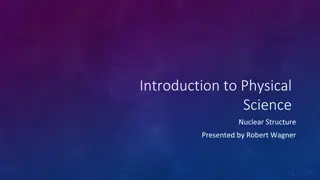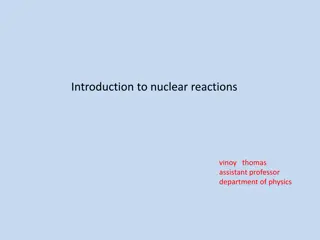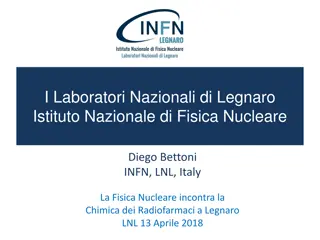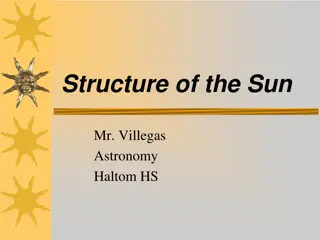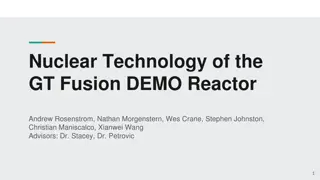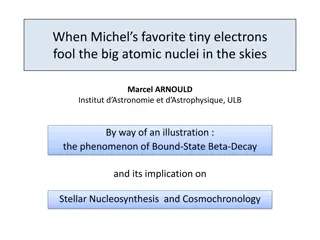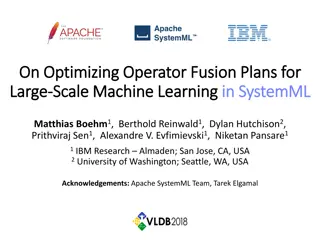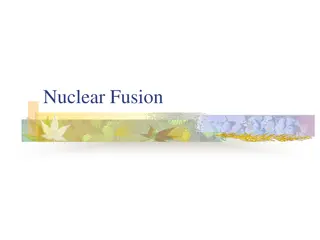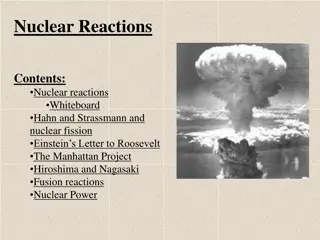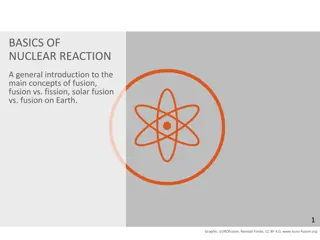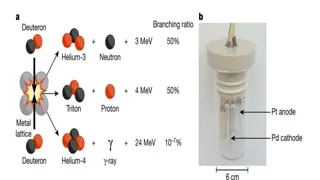Key Fusion Reactions in Nuclear Astrophysics
Fusion reactions play a crucial role in nuclear astrophysics, with key reactions involving light elements such as Li, Be, B, and stable carbon isotopes. Understanding fusion of light heavy nuclei at extreme energies is essential for predicting stellar evolution. The S-factor provides a convenient representation of fusion cross-sections at low energies, aiding in extrapolating data for astrophysical reaction rate predictions. Observations of S-factor structures in reactions like 16O+16O and 12C+12C impact data extrapolation. Challenges exist in measuring Gamow energies, but theoretical models offer potential solutions for studying fusion reactions in hydrogen-rich environments and explosive scenarios.
Download Presentation

Please find below an Image/Link to download the presentation.
The content on the website is provided AS IS for your information and personal use only. It may not be sold, licensed, or shared on other websites without obtaining consent from the author.If you encounter any issues during the download, it is possible that the publisher has removed the file from their server.
You are allowed to download the files provided on this website for personal or commercial use, subject to the condition that they are used lawfully. All files are the property of their respective owners.
The content on the website is provided AS IS for your information and personal use only. It may not be sold, licensed, or shared on other websites without obtaining consent from the author.
E N D
Presentation Transcript
Fusion reactions in nuclear astrophysics V. V. Sargsyan (BLTP, JINR) G. G. Adamian (BLTP, JINR) N. V. Antonenko (BLTP, JINR) H. Lenske (JLU, Giessen)
Key fusion reactions In a hydrogen-rich environment the light elements such as Li, Be, and B have all positive (p, ) Q values. These nuclei are easily destroyed, before fusion reactions start to play a role. The stable carbon isotopes 12,13C are the first nuclei with sufficiently negative (p, ) Q values. This makes 12C + 12C the first fusion reaction that needs to be considered in nuclear astrophysics. In non-explosive scenarios carbon fusion takes place in the center of massive stars toward the end of their lifetime during the carbon- burning phase at temperatures of about 0.6 1 GK. In stellar explosions carbon fusion plays a role during the ignition phase of supernovae (1 10 GK). Fusion reactions involving 16O, plays a role only at higher temperatures. In explosive environments.
Key fusion reactions The study of fusion of light heavy nuclei (C, O, Si ) at extreme sub- barrier energies (e.g. Gamow energies for C+C reaction is 1-3 MeV) is a key to understand and predict different scenarios of evolution of the stars. Main problem: Gamow energies are in a range where no reliable cross-section measurements can be made with present technologies. Possible solution: Extrapolation of the existing experimental data to lower energies starting with data at higher energies. Theoretical calculations.
S-factor More convenient representation of the fusion cross section at low energies = . ( ) ( ) exp( 2 ) S E E E . . . . . c m c m c m Gamow factor = 2 / v Z Z e v --- Sommerfeld parameter --- beam velocity 1 2 Some models predict, that the Gamow factor accounts for the main part of the strong energy dependence of the fusion cross section, such that the S- factor exhibits only a weak energy dependence far below the Coulomb barrier. This feature is often used to extrapolate the cross section into the region of the Gamow window, in order to predict the astrophysical reaction rates.
S-factor for 16O+16O reaction 16O+16O 104 104 S -factor (MeV mb) 103 103 7 8 9 10 102 101 J. Thomas, PRC 31 1985 G. Hulke, Z. Phys. A 297, 1980 S. -C. Wu, NPA 422 1984 A. Kuronen, PRC 591 1987 100 6 7 8 9 10 11 12 13 14 Ec.m. (MeV) Existence of a maximum in S- factor ? The maximum was observed in 64Ni+64Ni and 58Ni+58Ni reaction Jiang, PRC 93 2004 The structure of S - factor is critical for the extrapolation of data!
S-factor for 12C+12C reaction 3 10 12C+ 12C 4 10 S -factor (MeV mb) 1 10 -1 10 (mb) 3 10 -3 10 E. F. Aguilera, PRC 73 (2006) C. L. Jiang, PRC 97 (2018) M. D. High, NPA 282 (1977) M. G. Mazarakis, PRC 7 (1973) -5 10 2 10 3 4 5 6 2 3 4 5 6 7 Ec.m. (MeV) Ec.m. (MeV) More dramatic situation in 12C+12C reaction ! Resonant behavior at low energies does not allow to make a clear conclusion about the maximum.
The capture cross section For the light and medium-heavy nuclei the fusion is governed by the penetrability of the nuclei through the Coulomb and orbital angular momentum barriers (the so called capture). The capture cross-section is a sum of partial capture cross-sections ( ) ( ) ( ) ( ) = = + 2 , 2 1 , E E J J P E J c.m. c.m. cap c.m. c J J he partial capture probability at fixed energy and angular momentum ( E P c.m. cap ) , J Different approaches and models offer different methods of calculation of capture probability
The assumptions of the QD approach The quantum diffusion approach based on the following assumptions: 1. The capture (fusion) can be treated on the one collective variable: the relative distance between the colliding nuclei: R. 2. Collective coordinate is coupled to the internal excitations. 3. The internal excitations (for example, low-lying collective modes such as dynamical quadropole and octupole excitations of the target and projectile, single particle excitations etc. ) can be presented as an environment.
The formalism of QD approach The full Hamiltonian of the system: ( ) ( ) ( ) + + = + + + , , , H H R P H b b V R b b tot coll inter coupling 2 1 The collective subsystem (inverted harmonic oscillator) = 2 2 Hcoll P R 2 2 + = Hinter b b The internal subsystem ( ) + = + coupling V R b b Coupling between the subsystems (linear coupling)
Approximation: realistic nucleus-nucleus potential inverted oscillator The real interaction between nuclei can be approximated by the inverted oscillator. The frequency of oscillator is found from the condition of equality of classical action E . . c m b R inr exr inr b R exr
The analytical expressions for the first and second moments = + ( ) R t A R B P 0 0 t t t t 2 2 2 ) = ( ) coth cos ( t d B d B d RR + 2 2 2 T 0 0 0 3 A = + + s t ( ) s s e i t i i i Functions determine the dynamic of the first and second moments = 1 i 1 3 = = + s t ( ) B s e i t i i 1 i ( )( ) 1 is = s s s s --- are the roots of the following equation 1 1 2 1 3 ( )( ) 1 = s s s s 2 2 1 2 3 )( ) ( + + = 2 2 ( )( ) / 0 s s s 1 = s s s s 3 3 1 3 2
The capture probability in quantum diffusion approach Capture probability depends on the ratio of mean value and the variance of the collective coordinate: 1 ( ) R t = lim t erfc P cap 2 ( ) t RR The coupling to internal excitations leads to fluctuation of collective coordinate. Equations for the mean value and variance contain friction and diffusion. The friction and diffusion are obtained in a self-consistent way. Our approach takes into account the fluctuation and dissipation effects in the collisions of heavy ions which model the coupling with various channels.
The capture probability / 1 2 2 1 ( ) R s s = erfc P 1 1 ext cap 2 / 1 2 2 2 2 ( ) ln( / ) s s s 1 1 1 = s + ( ) s Constant friction coefficient was used. 1 2 + s + ( )( + ) s s The frequency of the approximated oscillator. = 2 2 1 2 ~ + 2 ( )( ) s 1 2 The internal excitation width --- is responsible for non-Markovian effects. The QD approach was successfully applied to describe the heavy ion fusion reactions at near- and below the Coulomb barrier energies.
Nucleus-nucleus interaction potential: The calculated potentials respect to their barriers for the indicated reactions 5 16O+ 16O+ 208Pb 16O 0 E .m . c V-Vb (MeV) -5 -10 -15 R ext -20 -4 -2 0 2 4 6 R-Rb (fm) The large Coulomb repulsion in case of the 16O+208Pb reaction leads to steep fall off of the potential, compared to those in case of 16O+16O reaction. The same energy below the Coulomb barrier, two colliding nuclei approach to closer distance in case of the heavier system.
External turning point The dependence of the external turning point on energy is completely different for reactions with light and heavy nuclei! 12 The Rext indicates the extent of the overlap of nuclear density profiles, which responsible for the nuclear friction. 16O+ 16O+ 208Pb 16O 10 8 Rext (fm) 6 At the same energy below the barrier, the external turning point is located much closer to the position of the corresponding Coulomb barrier in case of heavy system. 4 2 0 0 -1 -2 V-Vb (MeV) -3 -4 -5 -6 One need to include in model the dependence of friction on coordinate!
To consider reactions with light heavy nuclei one need to extend the model!! Include the energy dependence of friction, (dependence of the friction on the external turning point). At each energy, to find an effective frequency , which replace the real potential with an inverted oscillator in a proper way.
The friction is proportional to the square of the nuclear force: = 2 ( ) ( ( )) R V R Gross, Phys. Rep. (1978) Weidenmuller, Prog. Part. Nucl. Phys. (1978) 0 N This form of friction takes into account the comparatively larger overlap of the nuclear surfaces is case of two heavier nuclei. Determination of the frequency of the replaced oscillator: 1. The same height and the position of the barrier of the real potential with the height and the position of inverted oscillator. 2. The condition of equality of the energy under the barrier: 2 2 ext R = V E . . b c m 2 Determination of the excitation width: Markovian limit , 0 ( ) R = 1= ( ) exp R k k 0 1 2 ( ) R b
Probability at extreme sub-barrier energies At low energies (weak friction limit) one obtains simple expression for the capture probability ! ( ( ) 1 V E = erfc P . . b c m cap 2 ) k E 1 . . c m / 1 4 2 ( )( E ) 1 V E V E 2 = 2 2 b erfc 2 P R . . . . b c m C c m cap b 2 . . c m 2 z z e = V 1 2 --- Coulomb energy at R=Rb C R b For very light nuclei the formulas are applicable already at energies 1-2 MeV below the barrier. The formulas could be used to obtain analytical expression for the S- factor position and reaction rates.
Results of calculations 3 10 12C+ 12C 12C+ 12C 4 10 S -factor (MeV mb) 1 10 3 10 -1 10 (mb) -3 2 10 10 E. F. Aguilera, PRC 73 (2006) C. L. Jiang, PRC 97 (2018) M. D. High, NPA 282 (1977) M. G. Mazarakis, PRC 7 (1973) E. F. Aguilera, PRC 73 (2006) C. L. Jiang, PRC 97 (2018) M. D. High, NPA 282 (1977) M. G. Mazarakis, PRC 7 (1973) -5 10 1 10 -7 10 2 3 4 5 6 7 2 3 4 5 6 7 Ec.m. (MeV) Ec.m. (MeV) The main trend of new experimental data is reproduced. We clearly identify a maximum in S- factor.
Results of calculations 5 10 3 10 16O+ 16O 16O+ 16O 4 10 2 10 S -factor (MeV mb) 1 3 10 10 0 10 (mb) 2 10 -1 10 1 10 J. Thomas, PRC 31 1985 G. Hulke, Z. Phys. A 297, 1980 S. -C. Wu, NPA 422 1984 A. Kuronen, PRC 591 1987 J. Thomas, PRC 31 1985 G. Hulke, Z. Phys. A 297, 1980 S. -C. Wu, NPA 422 1984 A. Kuronen, PRC 591 1987 -2 10 0 10 -3 10 -4 -1 10 10 6 7 8 9 10 11 12 13 14 15 Ec.m. (MeV) 6 8 10 12 14 Ec.m. (MeV) The calculation is in good agreement with the experimental data The lowest data are very close to the position of the maximum of S factor
Results of calculations 4 12C+ 16O 10 12C+ 16O 2 10 S -factor (MeV mb) 3 10 0 10 2 10 -2 (mb) 10 1 10 -4 10 C. A. Barnes, NPA 266 (1976) X. Fang, PRC 96 (2017) P. R. Christensen, NPA 280 (1977) C. A. Barnes, NPA 266 (1976) X. Fang, PRC 96 (2017) P. R. Christensen, NPA 280 (1977) 0 -6 10 10 -8 -1 10 10 4 6 8 10 12 4 6 8 10 12 Ec.m. (MeV) Ec.m. (MeV)
Results of calculations 5 10 3 10 12C+ 30Si 12C+ 0 = 10.56 30Si 4 10 2 S -factor (MeV mb) 10 3 10 1 2 10 10 (mb) 1 10 0 10 0 10 -1 10 -1 10 -2 10 G. Montagnoli, PRC 79 (2018) -2 10 -3 10 -3 10 9 12 15 18 21 24 9 12 15 18 21 24 Ec.m. (MeV) Ec.m. (MeV)
Comparison with the WKB model The fluctuation and dissipation effects taken into account in our model (solid line) increase fusion probability at sub-barrier energies and decrease at above barrier energies compared to WKB model (dashed line).
3 10 3 10 40Ca+ 40Ca 28Si+ 30Si 2 10 2 10 1 10 1 10 (mb) (mb) 0 10 0 10 -1 -1 10 10 G. Montagnoli, PRC 85 (2012) H. A. Aljuwair, PRC 30 (1984) -2 -2 10 10 C. L. Jiang, PRC 78 2008 -3 -3 10 10 48 52 56 60 64 68 24 27 30 33 36 Ec.m. (MeV) Ec.m. (MeV) 103 40Ca+48Ca 103 48Ca+48Ca 102 101 101 100 (mb) (mb) 10-1 10-1 10-2 10-3 H. A. Aljuwair, PRC 30 (1984) M. Trotta, PRC 65 (2001) C. L. Jiang, PRC 82 (2010) 10-3 G. Montagnoli, PRC 82 (2010) 10-4 10-5 10-5 44 48 52 56 60 64 68 45 48 51 Ec.m. (MeV) 54 57 60 Ec.m. (MeV)
3 3 36S+ 48Ca 36S+ 64Ni 10 10 2 2 10 10 1 1 10 10 (mb) 0 0 (mb) 10 10 -1 -1 10 10 -2 -2 G. Montagnoli, PRC 82 (2010) 10 10 A. M. Stefanini, PRC 78 2008 -3 -3 10 10 -4 -4 10 10 35 40 45 Ec.m. (MeV) 50 55 60 50 55 60 65 70 75 80 85 Ec.m. (MeV) 3 10 4He+ 238U 4He+ 208Pb 3 10 2 10 2 10 1 1 10 10 (mb) (mb) 0 0 10 10 V. E. Viola, PR 128 (1962) M. Trotta, PRL 84 (2000) fission A. R. Barnett, PRC 9 (1974) (only 1-n channel) -1 10 -1 10 -2 10 15 20 25 30 35 40 16 18 20 22 24 Ec.m. (MeV) Ec.m. (MeV)
Summary In collisions of light nuclei at low sub-barrier energies, the external turning point is located far from the Coulomb barrier position. This means weak overlap of nuclear surfaces and, correspondingly, small friction. We extended our QD approach and considered the friction depending on the bombarding energy. Using the extended approach, we compared the calculated capture cross-sections with the available experimental data. In all cases we obtained a good description of the experiments. Comparing the fusion excitation functions calculated within the quantum diffusion and WKB approaches, we found that the fluctuation and dissipation increase fusion cross section at sub-barrier energies. The maximum in S-factoris predicted. However, more experimental data at low energies is needed to confirm our predictions. In the limit of weak friction, which corresponds to extreme sub-barrier energies, the analytic expression for the capture probability is obtained. This simple expression can be applied to the reactions of astrophysical interest. The strong decline of fusion cross sections at sub-barrier energies considerably reduces the stellar burning rates and, moreover, leads to severe experimental problems, inhibiting the measurements in many cases.
Nucleus-nucleus interaction potential: ) 1 + 2 ( J J ( ) = + + , , , V R Z A J V V i i Nucl Coul 2 2 R Double-folding formalism used for nuclear part: = ( ) ( ) ( ) VNucl d r d r r F r r R r 1 2 1 1 1 2 2 2 Nucleus-nucleus potential: 1. density - dependent effective nucleon-nucleon interaction 2. Woods-Saxon parameterization for nucleus density Adamian et al., Int. J. Mod. Phys E 5, 191 (1996).
Coordinate dependent friction The friction is proportional to the square of the nuclear force: = 2 ( ) ( ( )) R V R Gross, Phys. Rep. (1978) Weidenmuller, Prog. Part. Nucl. Phys. (1978) 0 N 2 the variation of 02 times leads to the change of the results of the calculations less then 5% ! = 0 2 ( ( ) ) V NR = R R b 1 10 This form of friction takes into account the comparatively larger overlap of the nuclear surfaces is case of two heavier nuclei. 0 10 16O+ 16O+ 208Pb 16O -1 10 -2 (MeV) 10 -3 10 The friction decreases more rapidly than the corresponding nuclear potential. -4 10 -5 10 -6 10 0 1 2 3 4 5 R-Rb (fm)
Propagator for the inverted oscillator For the inverted oscillator the propagator has the form: 1 ( ) = = , , , , 0 G P R t P R t 0 0 2 PR 2 ( ) ( ) ( ) t t t RR PP ( ) 1 ( )( t ) ( )( t ) ( )( t )( ) 2 2 + exp ( ) ( ) 2 ( ) ( ) R R t P P t P P t R R t PP RR PR 2 PR [ 2 ( ) ( ) ( )] t t t RR PP ( , ) t ( ) R P t --- the mean value of the collective coordinate and momentum 1 ( ) = = = ( ) 0 , 0 , t i, j R P ( ) t --- the variances and ij ij 2 Dadonov, Man ko, Tr. Fiz. Inst. Akad. Nauk SSSR 167, 7 (1986). The expression for the capture probability 1 ( ) R t = lim t erfc P cap 2 ( ) t RR


![[PDF⚡READ❤ONLINE] Cosmology and Particle Astrophysics (Wiley-Praxis Series in As](/thumb/21627/pdf-read-online-cosmology-and-particle-astrophysics-wiley-praxis-series-in-as.jpg)
